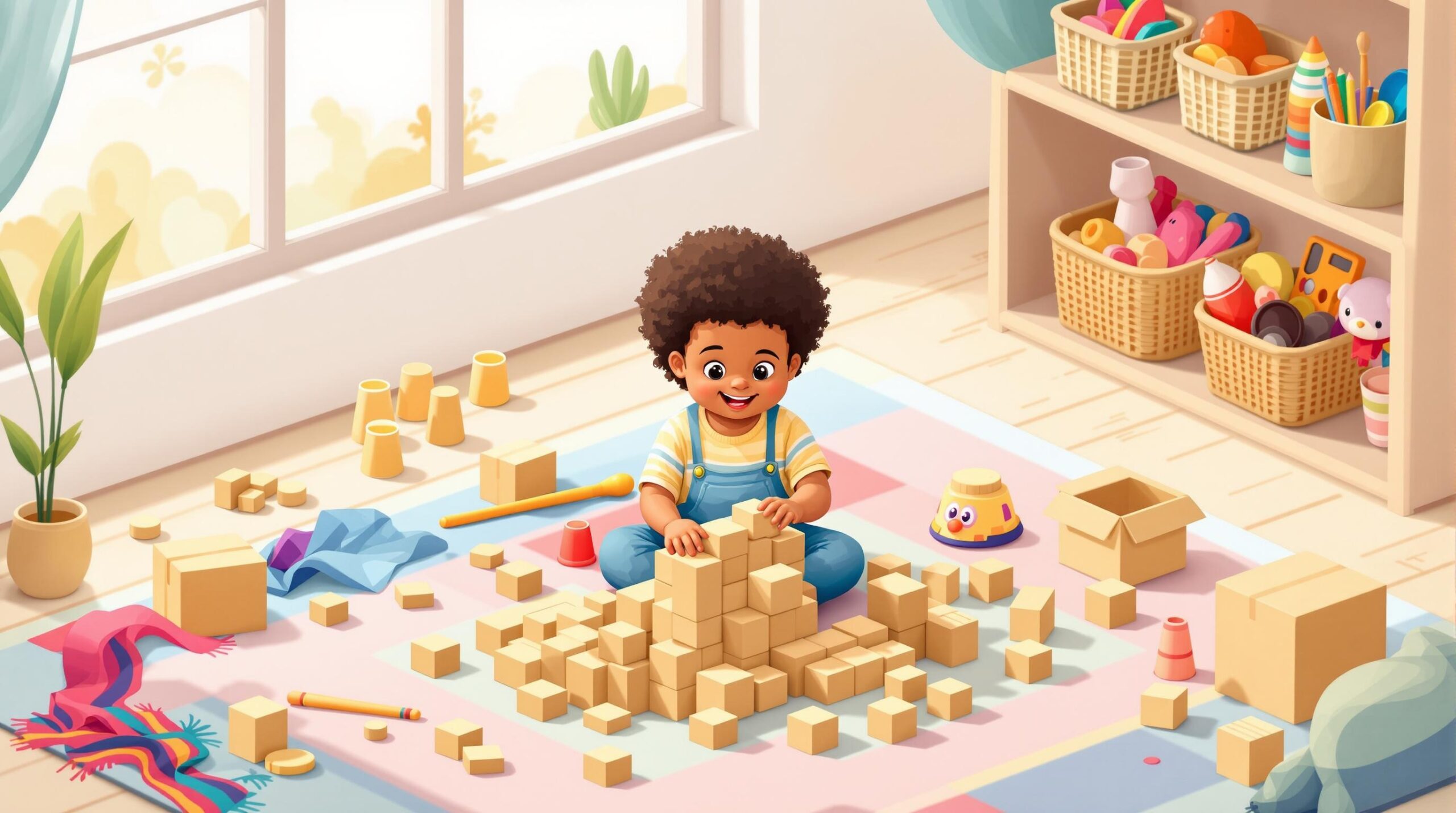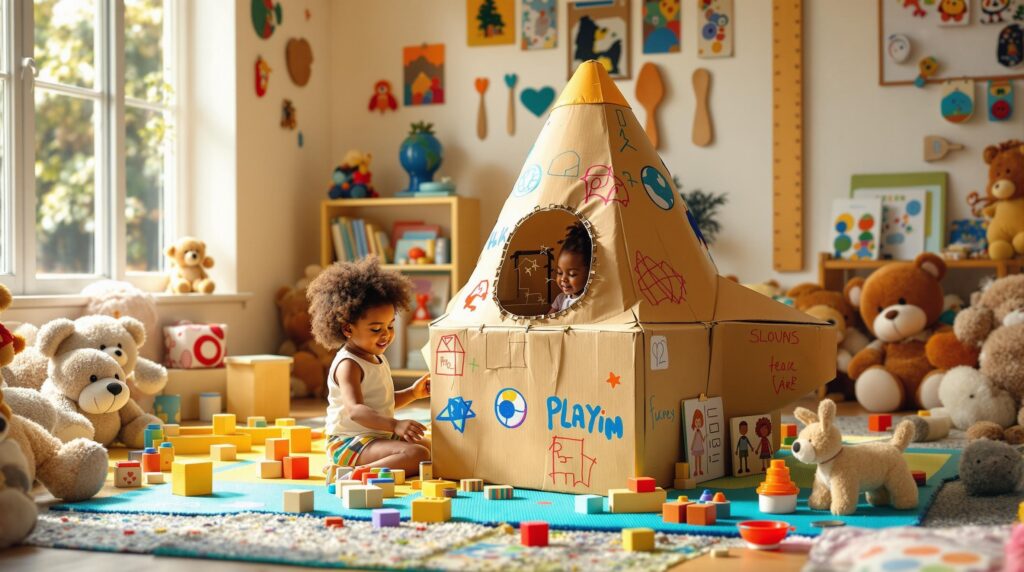Table of Contents
ToggleNurturing creativity in toddlers through open-ended play is a fantastic way to support their development and foster a lifelong love of learning. As a parent, you have the unique opportunity to shape your child’s early experiences and set the stage for their future growth. Let’s dive into the world of open-ended play and discover how it can benefit your little one’s creative journey.
The Power of Open-Ended Play for Toddler Creativity
Open-ended play is a type of play that doesn’t have a predetermined outcome or specific rules. It’s all about letting your child’s imagination run wild and encouraging them to explore, experiment, and create. This form of play is incredibly powerful for toddlers because it allows them to take charge of their own learning experience.
When children engage in open-ended play, they’re not just having fun – they’re actively participating in their own development. This type of play encourages:
- Problem-solving skills
- Critical thinking
- Imagination and creativity
- Self-expression
- Independence
By providing your toddler with open-ended play materials like blocks, dolls, or art supplies, you’re giving them the tools to explore their world and develop their unique ideas. This type of play allows children to learn at their own pace, fostering both cognitive and social-emotional development.
For example, when a child plays with blocks, they’re not just stacking them – they’re learning about balance, spatial relationships, and cause and effect. They might create a tower one day and a bridge the next, each time expanding their understanding of how things work.

Understanding Toddler Development Stages
To fully appreciate the impact of open-ended play on your toddler’s creativity, it’s helpful to understand the stages of cognitive development they’re going through. Jean Piaget, a renowned developmental psychologist, outlined several stages of cognitive development in children.
For toddlers, we’re primarily concerned with two stages:
1. Sensorimotor Stage (birth to 18-24 months)
During this stage, babies and young toddlers learn about the world through their senses and motor actions. They develop object permanence – the understanding that objects continue to exist even when they can’t be seen. Open-ended play at this stage might involve exploring textures, stacking cups, or playing peek-a-boo.
2. Preoperational Stage (2 to 7 years)
As toddlers enter this stage, they begin to use symbols in their thinking and play. This is when pretend play really takes off. Your child might use a banana as a phone or pretend a box is a spaceship. This type of play is crucial for developing symbolic thought and language skills.
Understanding these stages can help you encourage creativity and imagination in ways that are appropriate for your child’s developmental level.
Creating a Supportive Environment for Creative Play
The environment you create for your toddler can have a significant impact on their creative play. Here are some key factors to consider:
Safety First
A safe play area allows your toddler to explore freely without constant supervision. This doesn’t mean you shouldn’t be present, but rather that your child feels secure enough to focus on play rather than potential dangers. Ensure that play areas are childproofed and that all toys are age-appropriate.
Diverse and Inclusive Materials
Provide a variety of open-ended play materials that reflect diversity and inclusivity. This might include dolls of different ethnicities, books featuring various family structures, or toys that represent different cultures. This approach not only supports creativity but also helps your child develop a broader understanding of the world.
Parent Involvement
Your involvement in your child’s play is crucial. By participating in play activities, you’re not only bonding with your child but also modeling creative thinking and problem-solving. However, it’s important to strike a balance – be present and engaged, but allow your child to lead the play.
Developmental Milestones and Creative Play Activities
As your toddler grows, their play will evolve to support different developmental milestones. Here are some age-appropriate activities that can nurture creativity:
12-18 Months
- Stacking blocks or cups
- Simple puzzles
- Finger painting
- Playing with water and sand
These activities support fine motor skills and sensory exploration.
18-24 Months
- Pretend play with dolls or stuffed animals
- Playing dress-up
- Building with larger blocks
- Simple musical instruments
At this stage, toddlers begin to engage in symbolic play, a key developmental milestone.
2-3 Years
- Role-playing games
- Art projects with various materials
- Building more complex structures
- Outdoor exploration
These activities support language development, imagination, and gross motor skills.
Remember, every child develops at their own pace. These are general guidelines, and it’s okay if your child reaches milestones earlier or later.
The Parent’s Role in Nurturing Creativity
As a parent, you play a crucial role in nurturing your toddler’s creativity. Here are some ways you can support their creative development:
Provide Encouragement
Praise your child’s efforts and ideas, not just the end result. This encourages them to keep exploring and trying new things. For example, instead of saying “That’s a beautiful picture,” you might say, “I love how you used so many different colors in your drawing!”
Ask Open-Ended Questions
Encourage your child to think creatively by asking questions that don’t have a single right answer. For instance, “What do you think might happen if we add water to this sand?” or “How else could we use this box?”
Model Creativity
Show your child that creativity is valued by engaging in creative activities yourself. This could be as simple as making up silly songs together or finding new uses for everyday objects.
Embrace Messiness
Creative play can be messy, and that’s okay! Provide opportunities for messy play in safe, controlled environments. This might include finger painting, playing with playdough, or exploring in the mud.
By actively participating in your child’s creative journey, you’re not just making learning fun and engaging, but also building a strong foundation for future learning and problem-solving skills.
Cognitive Development Through Creative Play
Creative play isn’t just fun – it’s a powerful tool for cognitive development. According to Jean Piaget’s constructivist approach to learning, children actively construct their understanding of the world through hands-on experiences.
When toddlers engage in open-ended play, they’re constantly forming and testing hypotheses about how things work. This process involves two key concepts:
Assimilation
This is when children incorporate new experiences into their existing understanding of the world. For example, a child who knows that balls roll might apply this knowledge to other round objects.
Accommodation
This occurs when children modify their existing understanding based on new information. If a child tries to roll a cube and it doesn’t work, they might adjust their understanding of what objects can roll.
Through these processes, children develop and refine their schemas – mental frameworks for understanding the world. Creative play provides countless opportunities for this type of learning.
Fostering Social-Emotional Growth Through Play
Open-ended play isn’t just about cognitive development – it’s also crucial for social-emotional growth. Through play, toddlers learn important skills like:
Empathy
When children engage in pretend play, they often take on different roles. This helps them understand different perspectives and develop empathy.
Self-Regulation
Play often involves following rules or waiting for turns. These experiences help toddlers learn to manage their emotions and impulses.
Social Skills
As toddlers play alongside or with others, they learn important social skills like sharing, turn-taking, and cooperation.
Around age 2, toddlers begin to engage in parallel play – playing next to, but not necessarily with, other children. This is an important step towards more interactive play and can be supported through open-ended activities like block building or art projects.
Cultural Considerations in Creative Play
It’s important to recognize that play and child development can vary across cultures. Different cultures may value different types of play or have different expectations for child development.
For example, in some cultures, babies are carried close to their caregivers for much of the day. This practice can affect how and when babies develop object permanence, as they have different experiences with objects appearing and disappearing from view.
When providing play opportunities for toddlers, it’s crucial to consider and respect cultural differences. This might involve:
- Incorporating culturally relevant toys and materials
- Being mindful of different cultural attitudes towards play
- Recognizing that developmental milestones may vary across cultures
By embracing cultural diversity in play, we can create richer, more inclusive experiences for all children.
Practical Tips for Parents to Encourage Creative Play
Here are some practical ways you can encourage creative play in your home:
Rotate Toys
Keep a selection of toys in storage and rotate them regularly. This keeps play fresh and exciting without overwhelming your child with too many choices at once.
Create a Dedicated Play Space
If possible, set up a specific area for creative play. This could be a corner of a room with a small table, art supplies, and open-ended toys.
Limit Screen Time
While some screen time can be educational, it’s important to balance it with plenty of hands-on, creative play time.
Embrace Nature
Outdoor play provides endless opportunities for creativity. Collect leaves, play with mud, or build with sticks. These sensory activities boost toddler development in unique ways.
Make Time for Unstructured Play
In our busy lives, it’s easy to over-schedule. Make sure your toddler has plenty of time for free, unstructured play.
Remember, the goal is to provide opportunities for your child to explore, create, and learn at their own pace. By following these tips and embracing the power of pretend play and imagination, you’re setting your toddler up for a lifetime of creative thinking and problem-solving.
Nurturing creativity in toddlers through open-ended play is a journey of discovery – for both you and your child. By providing the right environment, materials, and support, you’re giving your toddler the tools they need to explore, create, and grow. Remember, there’s no one “right” way to play creatively. The most important thing is to enjoy the process and celebrate your child’s unique ideas and creations. Happy playing!
Sources:
Jean Piaget’s Stages of Cognitive Development
Development Milestones
Plain Language in Government Communications
NICHD Study of Early Child Care and Youth Development
Plain Language Standards












